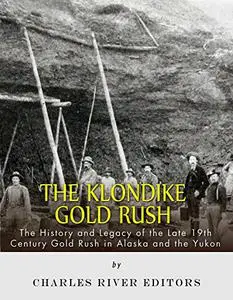The Klondike Gold Rush: The History of the Late 19th Century Gold Rush in Alaska and the Yukon by Charles River Editors
English | March 17, 2015 | ISBN: 1508909571 | 60 pages | EPUB | 2.11 Mb
English | March 17, 2015 | ISBN: 1508909571 | 60 pages | EPUB | 2.11 Mb
*Includes pictures *Includes accounts of the gold rush written by participants *Includes a bibliography for further reading *Includes a table of contents “Alaska is the land of the Nineteenth Century Argonauts; and the Golden Fleece hidden away among its snowcapped and glacier-clad mountains is not the pretty creation of mythological fame, but yellow nuggets which may be transformed into the coin of the realm. The vast territory into which these hardy soldiers of fortune penetrate is no less replete with wonders than the fabled land into which Jason is said to have led his band of adventurers. There is this difference, however, between the frozen land of the North and the fabled land of mythology. There is nothing conjectural about Alaska or its golden treasure. Jason led his band into an unknown country without the certain knowledge that the treasure he was seeking was there.” – A.C. Harris, author of Alaska and the Klondike Gold Mines (1897) One of the most important and memorable events of the United States’ westward push across the frontier came with the discovery of gold in the lands that became California in January 1848. Located thousands of miles away from the country’s power centers on the East Coast at the time, the announcement came a month before the Mexican-American War had ended, but it brought an influx of an estimated 90,000 “Forty-Niners” to the region in 1849, hailing from other parts of America and even as far away as Asia. All told, an estimated 300,000 people would come to California over the next few years, as men dangerously trekked thousands of miles in hopes of making a fortune, and in a span of months, San Francisco’s population exploded, making it one of the first mining boomtowns to truly spring up in the West. This was a pattern that would repeat itself across the West anytime a mineral discovery was made, from the Southwest and Tombstone to the Dakotas and Deadwood. Of course, it was all made possible by the collective memory of the original California gold rush; when gold was discovered in the Yukon and Alaska almost 50 years after the rush in California, it drew tens of thousands of prospectors despite the unforgiving climate. Mineral resources had gone a long way in the United States acquiring Alaska a generation earlier, but the lack of transportation kept all but the most dedicated from venturing into the Yukon and Alaska until the announcement of the gold rush. For a few years, the attention turned to the Northwest, and thanks to vivid descriptions by writers like Jack London, the nation became intrigued with the idea of miners toughing out the winter conditions to find hidden gold. Of course, despite the mythology and the romantic portrayals that helped make the Klondike Gold Rush, most of the individuals who came to make a fortune struck out instead. The gold rush was a boon to business interests, which ensured important infrastructure developments like the railroad and the construction of westward paths, but ultimately, it also meant that big business reaped most of the profits associated with mining the gold. While the miners are often remembered for panning gold out of mountain streams, it required advanced mining technology for most to make a fortune. Nevertheless, the Klondike Gold Rush and other gold rushes were emblematic of the American Dream and the notion that Americans could obtain untold fortunes regardless of their previous social status. As historian H.W. Brands put it, “The old American Dream … was the dream of the Puritans, of Benjamin Franklin's ‘Poor Richard’… of men and women content to accumulate their modest fortunes a little at a time, year by year by year. The new dream was the dream of instant wealth, won in a twinkling by audacity and good luck….” While the gold rush may not have made every miner rich, the events still continue to influence the country’s collective mentality.
Feel Free to contact me for book requests, informations or feedbacks.
Without You And Your Support We Can’t Continue
Thanks For Buying Premium From My Links For Support
Without You And Your Support We Can’t Continue
Thanks For Buying Premium From My Links For Support



